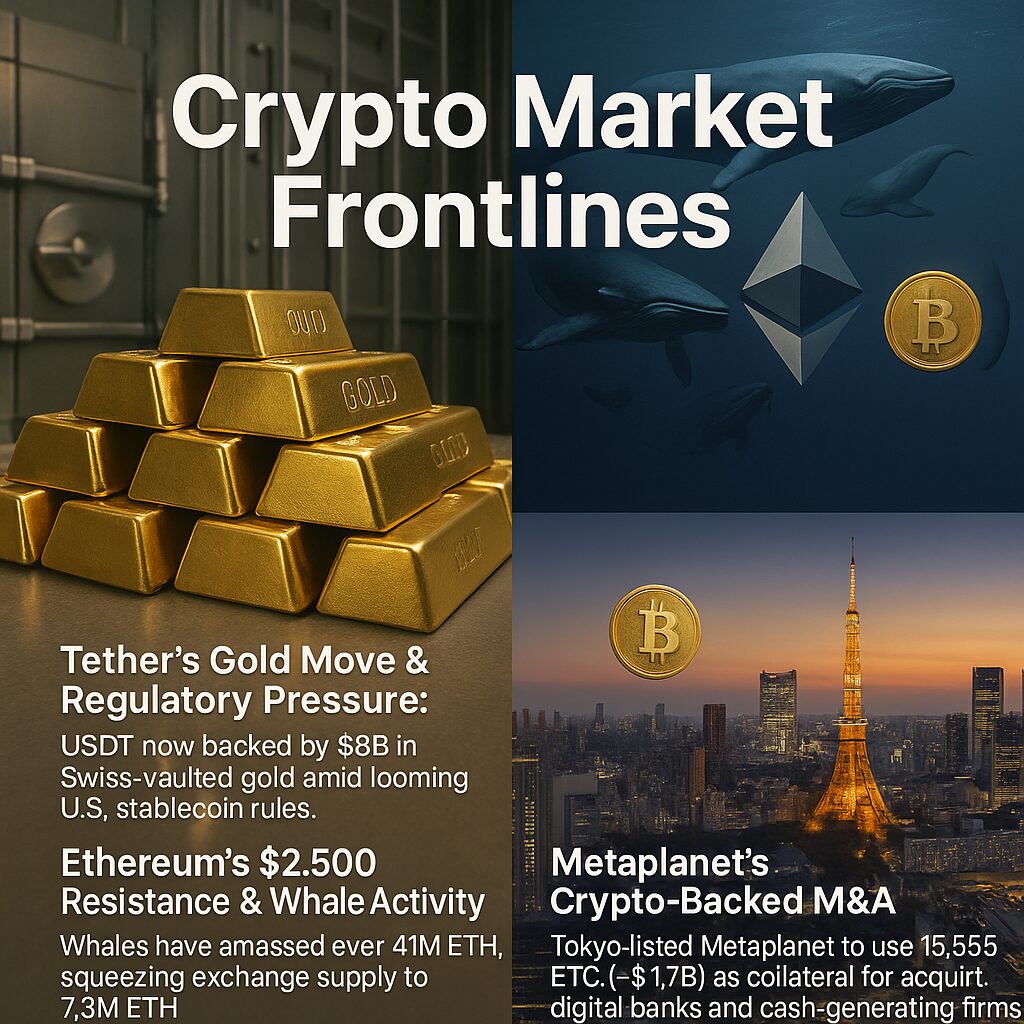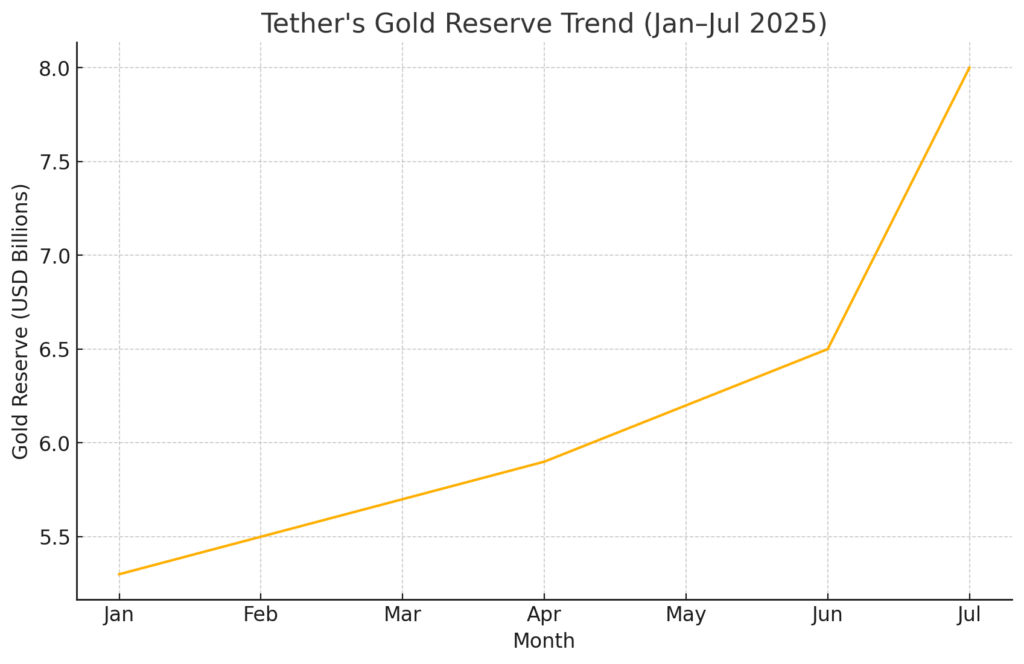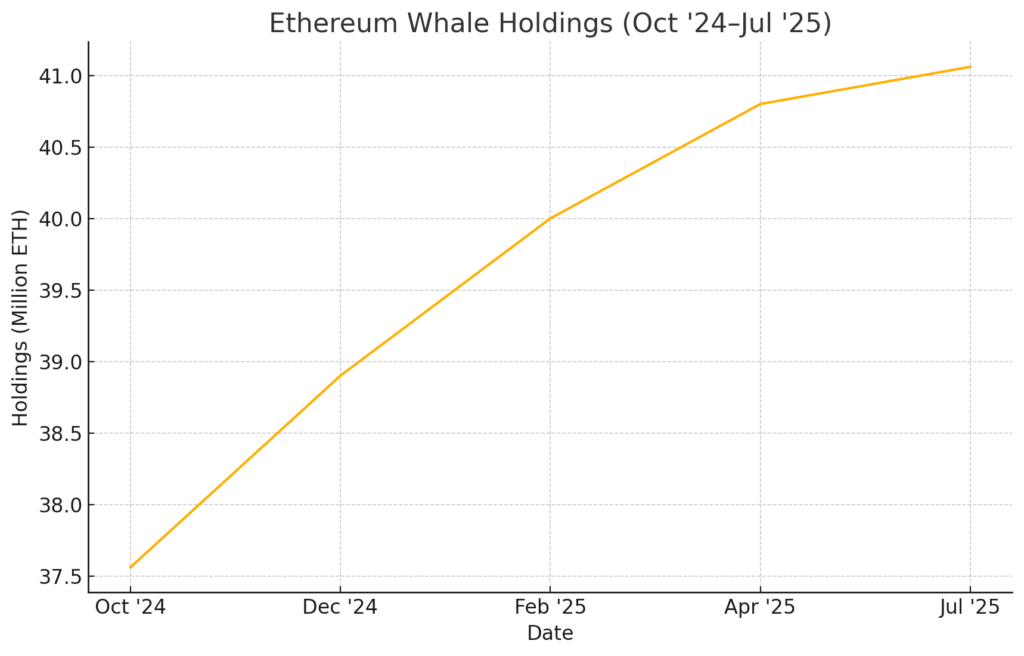
Main Points:
- Tether’s Gold Strategy: USDT issuer Tether has consolidated roughly $8 billion worth of gold (80 metric tons) into its own Swiss vault—about 5 % of its reserves—as it braces for evolving stablecoin regulations and seeks higher liquidity and trust.
- Ethereum Whale Accumulation: “Mega whales” holding between 1 000–100 000 ETH have added approximately 1.49 million ETH in the past 30 days, bringing total whale-held supply above 41.06 million ETH—a level not seen since early 2020—setting the stage for a potential breakout above the $2 500 resistance.
- Metaplanet’s Crypto-Backed M&A: Tokyo-listed Metaplanet, already holding 15 555 BTC ($1.68 billion), plans to use its Bitcoin treasury as collateral to acquire digital banks and other cash-generating firms, pioneering a “crypto-leverage” model in Japanese corporate finance.
1. Market Upheaval: Tether’s Gold Vault and the Shadow of Regulation

Tether’s USDT stablecoin underpins a vast portion of global crypto trading volume, with $159 billion in circulation. Traditionally backed by a mixture of cash, U.S. Treasuries, and precious metals, Tether has now moved almost 80 metric tons of gold—valued at about $8 billion—into a private Swiss vault it controls outright. This bullion represents roughly 5 % of Tether’s reported $112 billion reserve portfolio.
1.1 Why Gold, Why Now?
Tether CEO Paolo Ardoino calls their Swiss vault “the most secure in the world,” emphasizing gold as a “safer asset” than any fiat currency amid concerns over sovereign debt levels. But regulatory headwinds are equally influential. The EU’s Markets in Crypto-Assets (MiCA) framework, plus pending U.S. stablecoin bills, demand greater transparency and liquidity for reserve assets. By self-custodying bullion and potentially shifting toward more liquid assets, Tether aims to pre-empt stricter audit requirements while bolstering market confidence.
1.2 Systemic Implications
Releasing tens of billions of dollars’ worth of gold into the market could ripple through global finance, impacting gold prices and central bank policies. Yet, by consolidating in a private vault, Tether may absorb rather than flood supply, mitigating shock risks. The move also underscores stablecoins’ growing entanglement with traditional finance: as regulators clamp down, issuers blend crypto innovation with age-old safe havens like gold.
2. Ethereum’s Next Surge: Whale Accumulation Signals Breakout

Ethereum’s price has oscillated around the critical $2 500 level, forming a “strong accumulation zone” where buy orders and holding behavior concentrate. On-chain analytics reveal that wallets holding 1 000–100 000 ETH—so-called “whales” and “sharks”—have net-added about 1.49 million ETH in the past 30 days, boosting their aggregate stake to 26.98 % of total supply. Meanwhile, Glassnode reports that mega whales have reclaimed over 41.06 million ETH—the highest since February 2020—up from 37.56 million ETH in October 2024.
2.1 The $2 500 Resistance Zone
Historically, $2 500 has acted as both strong support and stiff resistance for ETH, reflecting a price regime where institutional and retail behaviors pivot. The current “accumulation zone” indicates that large holders view dips as buying opportunities, compressing available supply on exchanges to as low as 7.3 million ETH. If buying pressure continues, crossing above $2 500 could trigger algorithmic buy orders and FOMO, potentially launching ETH into new highs near $3 000.
2.2 Macro Drivers and Risks
Ethereum’s forthcoming Shanghai upgrades, the rise of L2 solutions like Optimism and Arbitrum, and renewed institutional interest—e.g., potential ETH ETFs—provide fundamental tailwinds. Conversely, regulatory scrutiny on staking services and possible macroeconomic shocks could sap momentum. Nonetheless, whale accumulation often presages sustained rallies, as reduced exchange supply creates scarcity during periods of heightened demand.
3. Japan’s Crypto Finance Revolution: Metaplanet’s Bitcoin-Backed M&A
Metaplanet—once a traditional hotel operator turned corporate Bitcoin treasurer—has amassed 15 555 BTC (~$1.68 billion USD at ~$107 800 per coin) and is now entering “phase two” of its strategy: using Bitcoin as collateral to secure financing for acquisitions of digital banks and other cash-generating enterprises.
3.1 From Treasury to Leverage
CEO Simon Gerovich describes this pivot as a “Bitcoin gold rush,” aiming to reach “escape velocity” where competitors cannot match Metaplanet’s scale. By depositing BTC with financial institutions—much like bonds or equities—Metaplanet plans to borrow cash at attractive rates, then deploy that capital to acquire businesses generating stable cash flows, starting with niche Japanese digital banks.
3.2 Strategic and Regulatory Considerations
While crypto-backed lending pilots have begun—e.g., Standard Chartered and OKX’s institutional trial—widespread acceptance remains nascent. Metaplanet’s approach tests the appetite of lenders for high-volatility collateral. Regulatory bodies in Japan will scrutinize the model to ensure financial stability, but success could catalyze a wave of crypto-collateralized corporate financing, redefining corporate balance sheets across Asia.
3.3 Broader Implications for Corporate Finance
If Metaplanet’s bold experiment succeeds, companies with significant crypto holdings may follow suit, transforming Bitcoin and Ethereum into mainstream corporate fungible assets. This could lower funding costs, diversify capital structures, and accelerate blockchain integration into real-world industry sectors. Critics caution that volatile collateral in down-markets could trigger margin calls and fire sales, but proponents argue that prudent overcollateralization and insurance mechanisms can mitigate systemic risk.
Conclusion
The crypto landscape continues to mature at a breakneck pace, as stablecoin issuers like Tether blend digital innovation with traditional safe havens, Ethereum whales accumulate into potential breakouts, and forward-thinking corporates like Metaplanet harness Bitcoin to fuel strategic expansion. These developments illustrate blockchain’s evolving interplay with global finance: a dynamic push-and-pull between innovation, regulation, and market forces. For investors and practitioners, staying attuned to on-chain signals, regulatory shifts, and innovative financing models will be essential to navigating the next chapter of the digital asset frontier.

